Knox Handroid Gloves Review
Unique, that’s for sure!
The Knox Handroid gloves look different and they are that, without a doubt.
It’s fun to watch the reaction you’ll get showing these to motorcycle riders…and to the rest of the unwashed masses.
Knox has developed a complex solution to be sure, but I have to admit, it’s pretty clever.
It took me a while to warm up to them but the more I wear ’em, the more I like ’em.
When I hear “Knox”, I think of the gelatin my father used to put in his pineapple juice every morning. “Keeps your fingernails from splitting”, he’d say.
OK, I guess, if you’re not into split fingernails. He’s 89 years old and his fingernails look pretty darned good to me, so I guess it worked.
In our world though, Knox is known mostly for their armor and back protectors.
But the company has developed what can only be called an “octopus” business strategy over the years, with each leg reaching out to a different aspect of rider protection.
OK, so I never claimed to be a whiz with the analogies…
But you can get an idea of this strategy by visiting the Knox website which is, appropriately enough, called “Planet Knox”.
There are at least five separate divisions within the company that was formerly known to us motorcyclists simply as “Knox Armor”. No worries; Knox, the traditional back protector company, is still alive, apparently.
They spun off different divisions, including Knox “Cold Killers” for windproof winter layers and the “Knox Lab”, the home of the Knox line of motorcycle gloves, including the Handroid and the new Biomech, Recon and Zero gloves.
Then there’s the “Dry Inside” division that developes base layers and finally the “Knox OE” division, tasked to work with other motorcycle clothing manufacturers to provide the Knox armor and products found in non-Knox brand gear.
Why the glove division is called the Knox Lab is anyone’s guess — mine is that the gloves were first developed in the lab and since the glove business didn’t fit anywhere else in the Knoxtopus (sorry), the Lab was it.
The Knox brand isn’t new to webBikeWorlders; indeed, several Knox products have been reviewed in the 11+ years we’ve been online.
These include the Knox Ricochet back protector (review); and the Knox “Cold Killer” underwear (review) back when it was first announced in 2007; the Knox Cross shirt and Cross Sport pants (review) and more.
The Knox Handroid gloves are not brand new and we’ve been planning a review since they were first released to production.
But North American availability was non-existent at first, and with so many other products to review, we sort of forgot about them until recently.
Now the Handroid gloves and others from the Knox “-droid” line are readily available pretty much worldwide, so it was time to take a closer look.
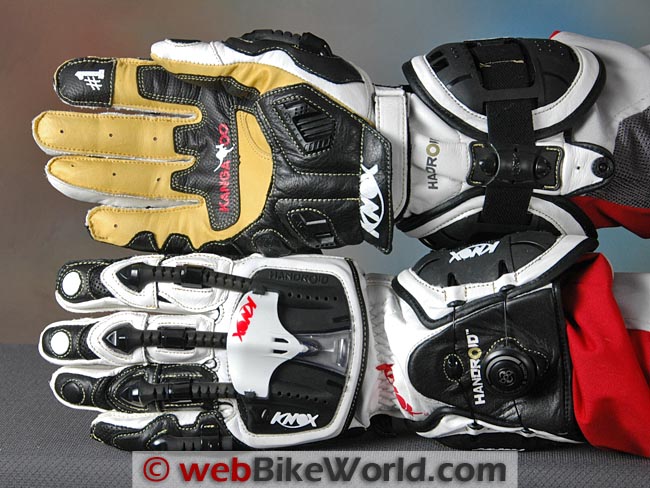
Where to Buy Knox Handroid Gloves
Check Reviews & Prices on Amazon Check Reviews & Prices On RevZillaAlso: Motorcycle Jackets, Motorcycle Gloves, Motorcycle Boots, Motorcycle Pants
Knox Handroid Gloves – Introduction
I’ll have to admit, I was as fascinated as everyone else when I first saw the photos of the Handroid gloves in the UK press. I didn’t think much about the reality — just that these gloves looked pretty cool, no doubt about that.
But when the gloves finally arrived, it didn’t take long to start thinking about the real-world implications of the two most notable features of these gloves: the “Exoskeleton Spines” on the fingers and the “Boa Lacing System” on the gauntlet.
In fact, I’ll go further and admit that the word “skeptic” was more appropriate than “believer” the first time I slipped a mitt into the Handroids.
But, as these things will happen (and strangely enough at that), the more I wore them, the more I started to like them and I’ve become a believer.
Yes — they are still a rather complicated (or complex) solution to the questions of protection and security, but I have to admit, it works. I’ve since talked to other Handroid owners, most of whom are rabidly pro-Handroid and will extol the virtues of the gloves for as long as you care to listen.
I do look at the Handroid gloves as “single-crash-use-only”, however, because I fear for the robustness of the Exoskeleton and Boa Lacing System. But, looking at it another way, all protective equipment is pretty much designed to protect you the one time it counts.
If the gloves do their job (let’s say if ever they should have to and let’s hope not) and I walk away with 10 digits in place, I’ll be more than happy to buy another pair and have at it once more.
In the meantime, the flip side of all this is that in my world of street riding, the Knox Handroid gloves are very comfortable — probably more comfortable than a full race glove has any right to be.
And this grudgingly late-to-the-Handroid-partier and now-near-believer will happily admit that the comfort provided during the time spent riding more than outweighs the potential destruction of the gloves when and if they should be gallantly called upon to do so.
Boa Lacing System
It may seem strange to start with what we usually describe last in a glove review…and something that is not one of the most obvious features on the Handroid Gloves; that is, the “Exoskeleton Spines” that run along the fingers.
I’ll get to those in a minute, but in the meantime, I’m convinced that the Boa Lacing System that is the real revolution here.
I initially thought that the Boa Lacing System was perhaps a made-up Knox name and since the Exoskeleton Spines are what first draws the eye to the Handroid gloves, the Boa dial on top of the gauntlet sort of plays second fiddle.
But, as it turns out, the Boa Lacing System represents a new direction in motorcycle gloves and it’s ironically on a part of the glove that doesn’t get much notice or respect — the gauntlet.
Sure, I’ve moaned about too-short gauntlets too often and it’s rather a pet peeve of mine. But the length of the gauntlet isn’t an issue at all on the Handroid gloves, however.
In fact, as I discovered, the Boa Lacing System was not developed by Knox; it’s a system licensed from Boa Technology, a company known to snowboarders and other left-coast outdoorsy types.
Boa headquarters are located in Steamboat Springs, Colorado and the closure system, which is a high-tech substitute for Velcro and shoelaces, was first developed for snowboarding.
Boa closures are used in equipment such as hiking boots, running and bicycling shoes, inline skates and even bicycle helmets. There are also medical uses for the Boa system; it provides an even and secure closure on arm or leg braces.
Basically anything that needs a secure lacing system with a “glove-like fit”, a “smooth, even closure” and “no pressure points” is a prime candidate for a Boa Lacing System. And let’s not forget the “micro-adjustability” and “on-the-fly fine tuning” features. With one hand, no less.
The Boa system comes in three flavors: mild, medium and extra-strong.
The high-power system is designed for snowboard boots and other types of heavy-duty gear. The “Mid-Power” system works on inline skates and hiking boots and the “Low Power” system is for street and running shoes and the rest.
I’m guessing that the low-octane version is all that’s needed to tighten up a motorcycle glove gauntlet, but I don’t know for sure and there’s nothing in the Knox spec sheet that gives a clue.
In fact, Knox doesn’t say much about the Boa system at all.
It’s a rather complex solution to the quaint button, lacing or hook-and-loop closures, but it does have some distinct advantages for motorcycle gloves. You can read all about the advantages of the Boa Lacing System on their website to learn how it works.
For the Knox Handroid gloves, the system consists of a special Boa “lace reel” with what appears to be something like nylon fishing string, but is actually claimed to be “49 individual strands of aircraft grade stainless steel wire” that is “compressed for a smooth surface and incredible strength”.
If there are 49 strands of wire in there, they must be as thin as spider’s milk.
Boa also claims that the wire is nearly unbreakable. “Gram by gram, it is stronger than tank armor” is the claim. Hey — isn’t that what they say about Kevlar?
The cables run through sections of nylon tubes that surround the gauntlet. The ratcheted dial is standard on the Boa system and as it’s turned, the string or, rather, cable is tightened. Pull up on the dial and the string immediately loosens.
What this provides is a very even and complete tightening of the gauntlet all the way around.
Where a hook-and-loop system would tighten only along the bottom of the gauntlet — and can wear out (and fail) — the Boa system is guaranteed for life. It’s a different feeling — it doesn’t feel like the gauntlet is as tight, but the security is there.
Using the Boa system also allowed the Knox Lab designers to create a two-part gauntlet cuff with slider/protectors on either side. These “float” on the gauntlet, attached by two rows of the nylon string. A wide section of elastic provides tension on the bottom.
The cuff opens up nice and wide to about 130 mm and the two sliders even wider. This allows the gloves to fit nicely over a variety of motorcycle jacket sleeves and the Boa system accommodates them. It’s unique and, as far as I know, Knox is the only company currently using it on motorcycle gloves.
This is all illustrated in the video we included below.
The Handroid gloves were the first to use the Boa system and Knox now has a “-droid” family of gloves that also use it, including the Handroid Pod, a short version of the Handroid; the Biomech, the Recon and the Zero gloves. These cover the range of uses from race (Handroid) to waterproof touring (Zero).
I’ll bet we’ll see more use of the Boa Lacing System on other gloves, along with motorcycle boots and other gear.
The potential downside of the Boa Lacing System used on a motorcycle glove is the issue of what happens when the dial grinds along the pavement as you’re doing the street luge.
It’s supposed to stay closed, more securely than hook-and-loop, according to Boa.
But where you could get back on and keep going with standard TPU or nylon sliders and hook-and-loop, you may be out of commission with a nub of Boa dial left hanging.
But again, this is offset by the comfort provided by the system for the other 99.999% (let’s hope) of the time that you’re riding and not tarmac sliding.

Where to Buy Knox Handroid Gloves
Check Reviews & Prices on Amazon Check Reviews & Prices On RevZillaAlso: Motorcycle Jackets, Motorcycle Gloves, Motorcycle Boots, Motorcycle Pants
Knox Handroid Exoskeleton Spines
The most obvious distinguishing characteristic of the Handroid gloves and the feature that puts the “-droid” in Handroid is the so-called “Exoskeleton Spines” running along the back of the fingers.
Once you get over the “Hey — that looks cool!” factor, you may start to wonder if they’re supposed to replace the hard TPU armor commonly found on motorcycle race gloves.
The answer is yes. It seems strange and still does — these half-domed strips of, well, Exoskeleton are also the sliders.
They’re attached at the main knuckles with springs that pull back on the fingers very slightly. This provides a sort of “neutral buoyancy” to the fingers as you hold the brake and clutch lever with two fingers.
I noticed a decrease in effort and my hands feel less tired than they sometimes do with other gloves that require a constant grip pressure to counteract the pull of the leather. I’m not sure if Knox had this benefit in mind when they designed the gloves, but it’s there.
I’m not so sure about the protection offered by the Exoskeleton Spines; I’ll have to trust the Knox designers on that one.
I can say that at first I thought the round-topped spines would easily roll to one side or another, defeating any protection they might offer. But they’re firmly (and cleverly) anchored on the middle segments (middle knuckles) of the fingers, which also serve double-duty as sliders.
They have a half-moon cross section; flat on the bottom where they meet the gloves. The sections are cut along the top, which provides the flexibility.
The skeletons then run through nylon or TPU “pipes” that function as sliders and they end inside the main knuckle protector that covers the back of the hand and floats on a separate section of leather and padding.
The action of the spring somehow gives the fingers a very nice feel. The muscles in the human hand allow it to make a fist with a lot of force, but the hand is much weaker when it comes to opening up.
The springs help by adding some reverse pulling power and it helps to reduce tension.
My conclusion on the Exoskeleton Spines is similar to the Boa Lacing System. It is a complex solution and certainly different from the norm, but it does have some advantages and it takes a fresh approach which also requires a new mindset and an openness by the owner to new ideas.
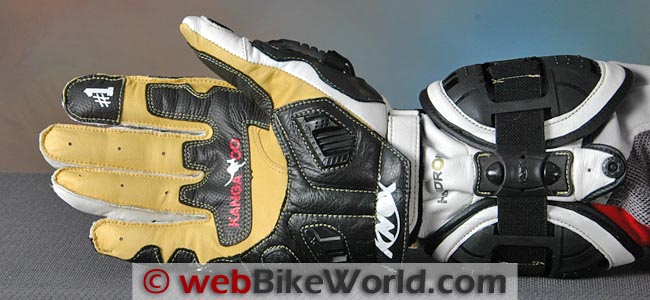
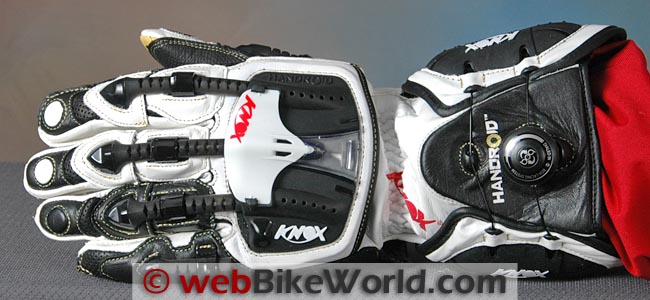
Other Features of the Handroid Gloves
While you may or may not agree with the new direction the Knox Lab designers took with the Exoskeleton Spines and Boa Lacing System, the Handroid gloves do include the full range of features typically found in a pair of “full race” motorcycle gloves.
This includes some high-quality “Japanese race quality drum dyed Aniline leather” in the body of the gloves and kangaroo leather in the palms. Both types are soft and supple and, honestly, I was surprised at how comfortable the gloves were right out of the package.
The Handroid gloves are CE-approved as a Personal Protective Equipment Category 1, according to the label.
Stitching and Armor
Most of the glove uses an external stitching method, which keeps the seams on the outside and helps make the insides smoother.
I wore the Handroid gloves back-to-back with the street-oriented Dainese Carbon Cover gloves (review) and the difference in internal comfort is apparent.
I can feel no seams at all inside the Handroid gloves and the entire upper part of the gloves and fingers are lined with a soft fabric that also helps keep things nice and smooth inside.
The gloves also include the Knox “SPS”, or Scaphoid Protection System, completely surrounding the hand on all sides and the heel of the hand with TPU or nylon sliders. Knox says that the system helps make the hand slide rather than grab, which can prevent injuries to the fingers, hands, wrist and arms.
This is the Full Monty of scaphoid protection — I don’t think there’s another square millimeter to fit another piece of TPU, so it doesn’t get much better than this.
In addition to the Boa Lacing System on the gauntlet and cuff, the Handroid gloves have the standard hook-and-loop wrist closure on the underside, covered with a leather flap for added protection.
Where to Buy Knox Handroid Gloves
Check Reviews & Prices on Amazon Check Reviews & Prices On RevZillaAlso: Motorcycle Jackets, Motorcycle Gloves, Motorcycle Boots, Motorcycle Pants
Fit and Ventilation Comfort
The fingers of the Handroid gloves taper down on top, race style, but in another surprise, the gloves are perfectly fitted and exactly to size for my hands.
This includes the little bit of extra length required for wrapping around the hand grips. I’m surprised because I often have a problem with the tapered style of fingertips.
The gloves shown here are labeled a size L/10 and — unusual for me — every section of the gloves is a perfect fit for my hands, with just enough room where it’s needed.
The stitching is external on the fingers also but Knox does not list the type of stitch fabric used. There are one or two very slight nubs of thread hanging here and there but they do not seem to be loose and I don’t think they affect the integrity of the construction.
II have heard some complaints by Handroid owners of loose stitching — perhaps on early production versions? The stitching appears to be all done by hand and it’s very complex, so I would imagine the learning curve is steep.
The Handroid gloves are not perforated other than a tiny area at the tip segment on top of the fingers and a few holes in the fingers on the palm side.
There isn’t much air flow but the kangaroo leather seems to breathe better than other types and the soft liner on the upper part of the inside of the gloves does a good job of controlling moisture.
The Knox Handroid gloves certainly are different.
They definitely caused a series of opinions to roil around in my head; at first, I thought they were cool. Then when they first arrived, my feelings changed to thoughts of gimmickry for its own sake.
But then as I started to wear them I warmed to the concept.
There are some concrete benefits to the new design in terms of comfort and, perhaps, safety. The Boa Lacing System is supposed to be guaranteed for life, according to Boa (here’s the Boa Technology FAQ page). Strangely enough, Knox doesn’t reference this guarantee; indeed, they seem to have downplayed any relationship with Boa.
The Exoskeleton Spines running down the fingers have a potential benefit of protecting nearly the entire top of the finger with a slider, rather than just the first and middle finger segments.
And on many race gloves, the pinky finger goes without any hard slider protection, where the Handroid gloves have five-finger sliders.
All of this comes at a price, however. The Handroid gloves have a list price of £159 in the UK and $249.95 in the U.S.A. But on the other hand (pun again), that’s around the same price you’d pay for a pair of premium race gloves without all the high-tech features.
So I’ve gone from being a pretty fair skeptic to becoming a fairly good believer in the system. This is based on the real-world street riding experience wearing the gloves — even though they’re supposed to be “race” gloves.
I would definitely recommend a consideration of the Handroid gloves if you’re in the market for a pair of high-end race gloves. And I am very interested in hearing from other Handroid owners regarding their thoughts and experiences.
Where to Buy Knox Handroid Gloves
Check Reviews & Prices on Amazon Check Reviews & Prices On RevZillaAlso: Motorcycle Jackets, Motorcycle Gloves, Motorcycle Boots, Motorcycle Pants
Owner Comments and Feedback
See details on submitting comments.
From “E.S.” (March 2013): “I bought a pair of Handroids at a bike fair several months back and I have to say they are super cool gloves. I’m a safety nut and even though I had a pair of hard plastic Duchini’s that work fine I don’t regret splashing out on these.
The only thing I would advise people to do is remove the plastic spoiler on the knuckle of the glove. A guy at a track day showed me what the spoiler can do to your finger if you’re unlucky enough in a crash. It almost sliced his pinky off!
The glove looks cool without them, I think its actually better looking with them off so its no big loss to remove it, and without it attached I’m super confident of these gloves.”
From “B.R.G.” (April 2012): “I have been wearing the (Knox Handroid Gloves) for about a season and a half now. They have broken in well and are quite comfortable – although the ventilation or lack thereof can be a bit sweaty on 90 plus days.
That being said, I put these gloves to the test and slammed into the ground on a low side after locking the front brake on what appeared to be oil or antifreeze. I hit palms down and slid for at least thirty five feet before slamming into an embankment.
The palm armor took the brunt of the slide and the protective qualities of the gloves remained unaffected. The leather and seams remained solid. The plastic wings on the top of one of the gloves was smashed and the rubberized exoskeleton took a major hit and was abraded.
My hands were completely fine after the incident and considering the gloves took some repeated slides and hits, I was shocked at how well they held up. Solid product and I would buy them again in an instant.”
From “C.R.” (January 2012): “I purchased these gloves to replace some beloved old Joe Rocket gauntlet-style gloves. Though they’re still stiff and tight, since they’re new, they have a great feel.
The webBikeWorld review was accurate and the other comments and feedback cover most of what wasn’t in the review, but I’ve found two additional unmentioned items that affect me.
First, the tan kangaroo leather “blackened” quickly from my ’94 VFR’s black rubber grips. I never noticed this on my old gloves, as they were all black. Not a big deal, but my pricey new gloves didn’t look quite so new after the first ride.
The next item concerns the plastic “sliders” on the heel of the palm. They alter the angle from which my hands wrap around my grips, compared to the old Joe Rocket gloves. They raise the outer part of my palms up and away from the grips. It’s made control a little awkward right now, but I’m sure I’ll adapt over time.
Also, at long stop lights, I often have a habit of resting my palms on my tank. I’m not comfortable doing that with these gloves, however, since I’m afraid that the hard plastic sliders will mar the paint’s finish.
In addition, I had a no-speed tip-over today (pant leg caught on left foot peg; embarrassing) and the white plastic “airfoil” popped off of my left glove when my hand hit the ground, but it was a simple matter to pop it back in place. The gloves, and more importantly my hand, suffered no real damage.
The dirty palm leather and palm slider grumbles aside, I REALLY like these gloves. They seem to be manufactured with a high level of quality, the Boa retention system works much better than the hook-and-loop systems I used previously, and, though I feel the exoskeleton spines are a gimmick, they’re definitely visually stimulating. Thanks for the great review, Rick K!”
From “M.S.” (November 2011): “Bought these gloves before I even passed my test but opted for the pod version which isn’t armoured on the gauntlet section but allows the glove to fit snuggly under the jacket sleeve (works fine with the Rallye 3 suit from BMW).
Have worn these in the U.K. from winter to summer and back again. Your hands do get cold if soaked and riding for more than a couple of hours non-stop (heated grips will keep your pinkies warm and also treated mine with a water-proofing spray) but other than that a highly protective glove that looks cool as well.
The only downside is the price — but then how much would you pay not have your fingers broken in several places at one sitting? Lol. The level of sensitivity in the fingers is fantastic.
I’m a medic working in the middle east and I can honestly say the feeling I get through the fingers on these gloves is almost the same as thick medical latex gloves. So if you bike has lots of bells, whistles and switches then these are for you!”
From “C” (September 2011): “Thanks for all the reviews and articles that you guys publish! I’ve been following webBikeWorld since I discovered it while searching for articles and information on the Ducati GT1000 a few years back.
Having worn these gloves on a daily basis for one year now (I got them as a birthday present last year), I would recommend them to anyone (who doesn’t mind attracting a lot of attention) looking for a pair of good gloves.
These are my first gauntlet length gloves and I was concerned that they might be warm and sticky to wear (I’ve only worn shorties up to that point and I’m in Singapore). However, these gloves have been surprisingly comfortable through tropical heat and humidity and they’ve only become more comfortable to wear with time. They do get stiff after drying out from wet weather, but the suppleness comes back with a day or two of riding.
I like the Boa lacing system. It provides a very comfortable and firm way to secure the gloves to your hands and gives the glove a nice custom fit/feel once tightened up. No problems with the tightening mechanism yet.
Right now, the only signs of wear on these gloves are on the small patches of black leather stitched to the tip of the index fingers. All the stitching is intact and none of the plastic bits have broken, cracked, or fallen off.
On the whole, although these gloves are a little pricey, I find the quality of build + extra protection and comfort they have are well worth the extra penny.”
From “J.C.” (September 2011): “I’ve had these gloves for just over a year. I bought them after breaking my thumb while wearing just plain leather gloves. I had a friend in the UK buy them and send them to me.
I had the same first impression… wow… almost like I was putting on StormTrooper gloves. As I used them, the comfort level grew… so not only are my hands well protected, but they are extremely comfortable.
I was concerned about the lack of visible ventilation. As it turns out, the white wing on the back of the hand diverts air to the inside of the glove, providing much needed cooling during those the warm (errr…hot) summer rides.
I’ve worn them in colder weather too, around 50 F and it wasn’t too uncomfortable.
I wonder if we will ever see a pair of these for use when it is colder. I did get caught in a rain storm with these and they acted like any other leather glove. My hands were soaked but I was still able to ride. When they dried out, it only took putting them on and flexing to get the comfort factor back.
I’m a big fan after having these for the past year! Thanks for the great reviews and info!”
From “R.B.S.” (September 2011): Here is an interesting counterpoint to your Handroid glove review: KNOX Handroid warning (YouTube video).
Rick’s Reply: I’m having a very difficult time understanding what he’s saying. I guess I don’t see a problem though — looks like he beat the heck out of a pair of gloves that still look in pretty good shape to me, and he’s complaining about something?
I’d say it’s time for him to buy another pair of gloves, those look pretty stale. We don’t know how long he’s had them, what he’s done with them, if he’s crashed in them…
The good news to me is that both the Boa system and the Exoskeleton appear to be in fine shape!

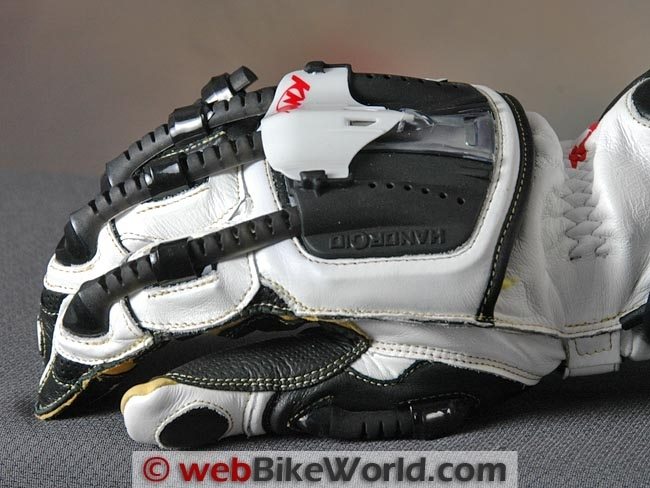
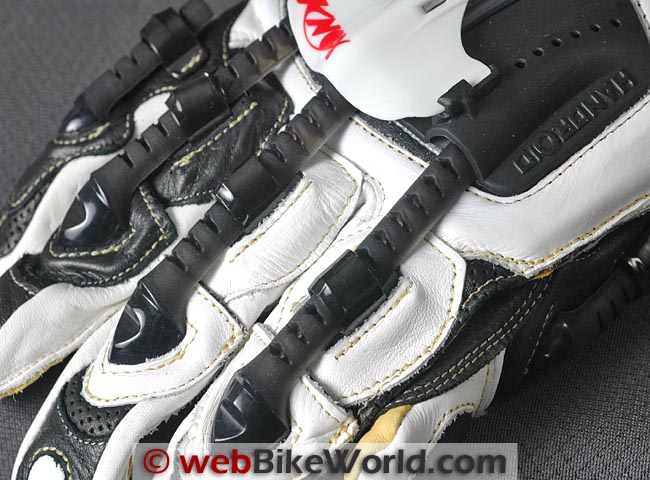
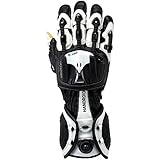
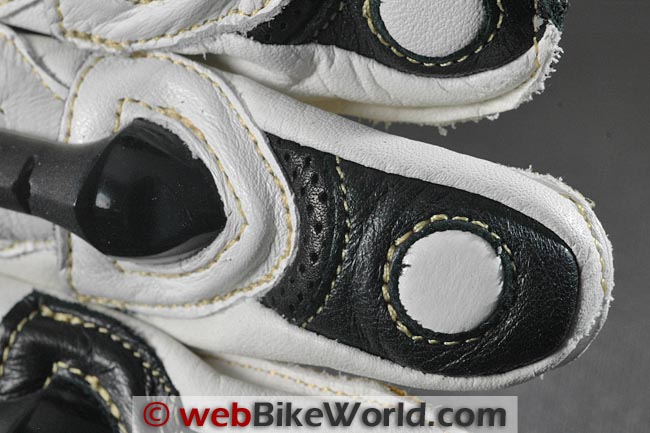
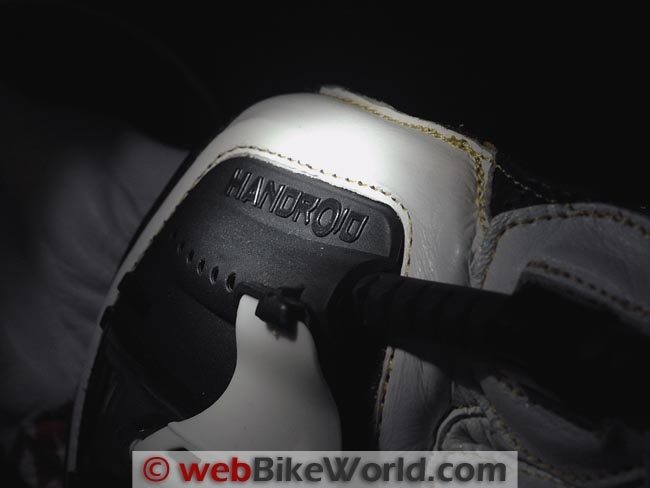
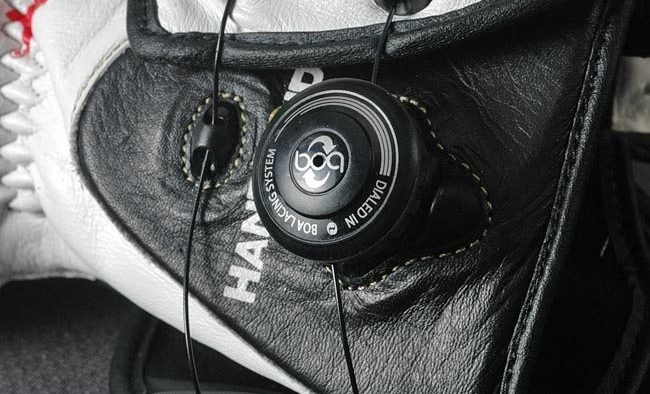
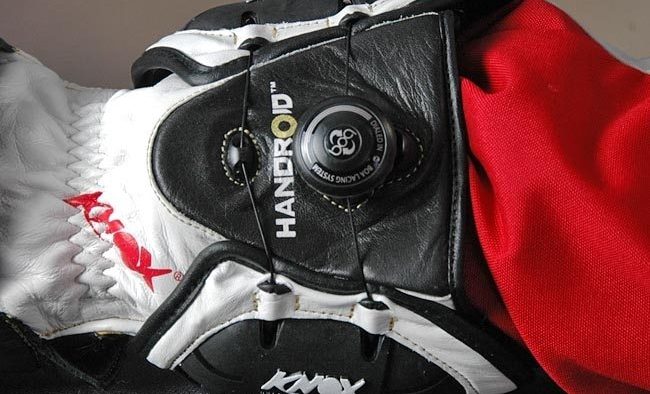

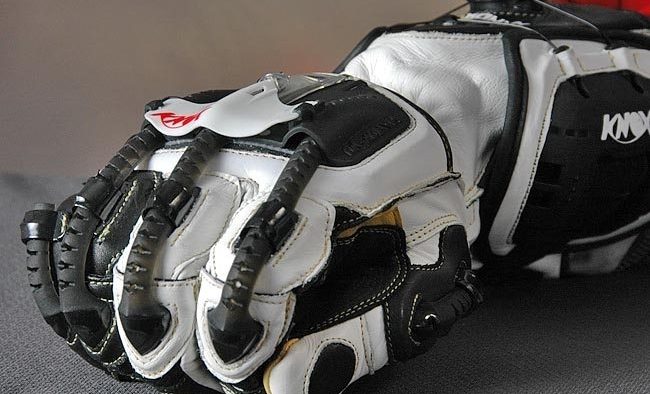

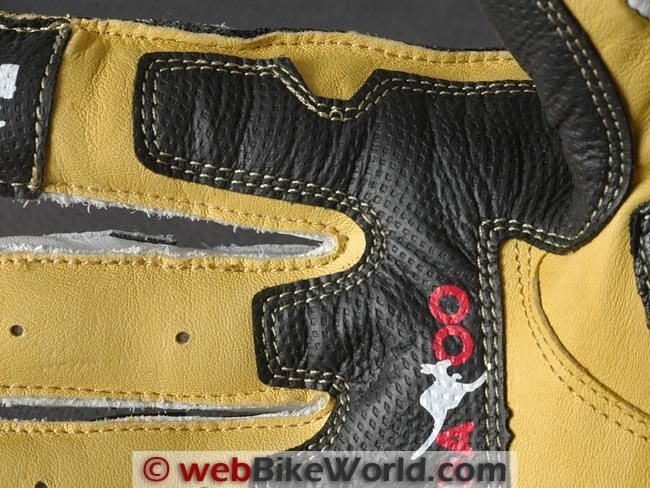
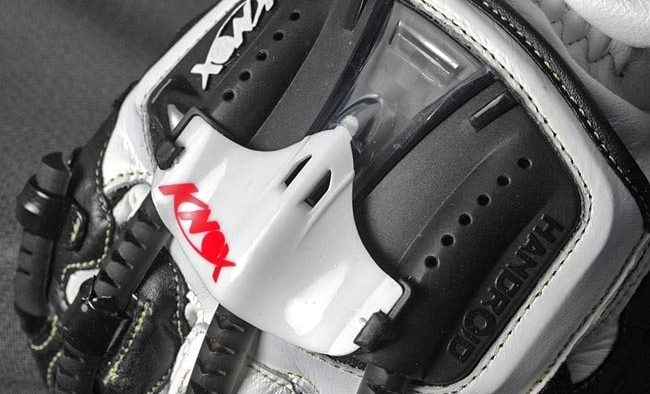
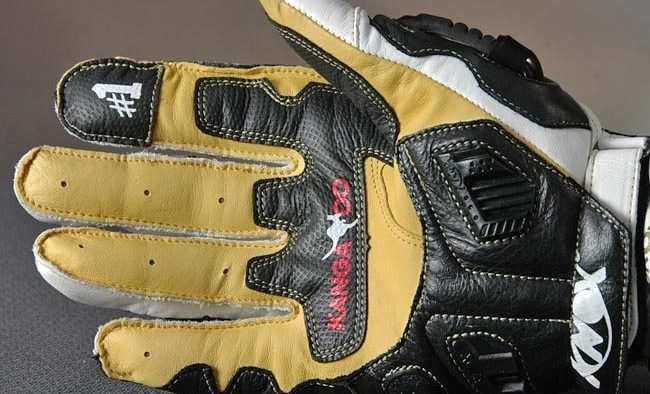
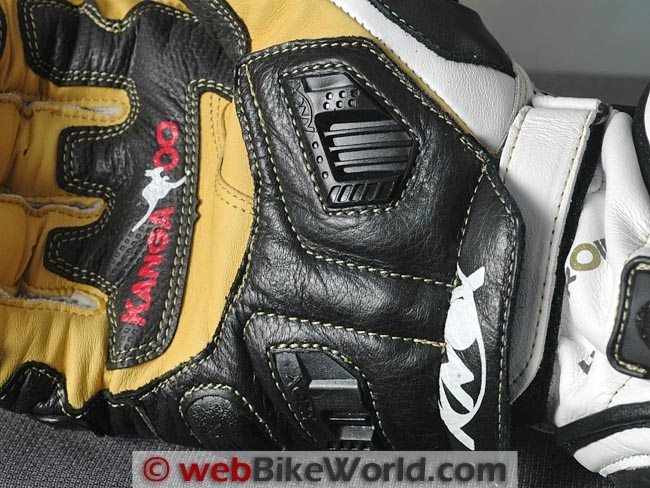
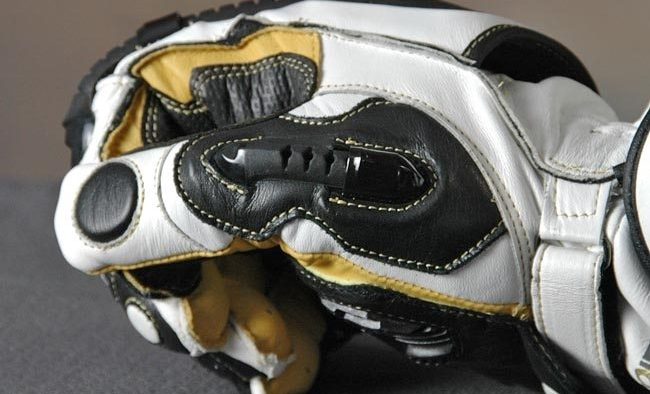



This glove is downright dangerous in that it puts look ahead of safety. My friend went down with these gloves and the BOA button slammed hard onto his upper arm. Did some major damage to his tendon. Its irresponsbile for a company to put gimmicky gadgets that can cause injury on motocycle gloves. The BOA system is simply unfit for use for this purpose. Imagine if the laces get caught when you are sliding? It will proably tear your hand clean off!!! This is why every reputable manufacurer use velcro.